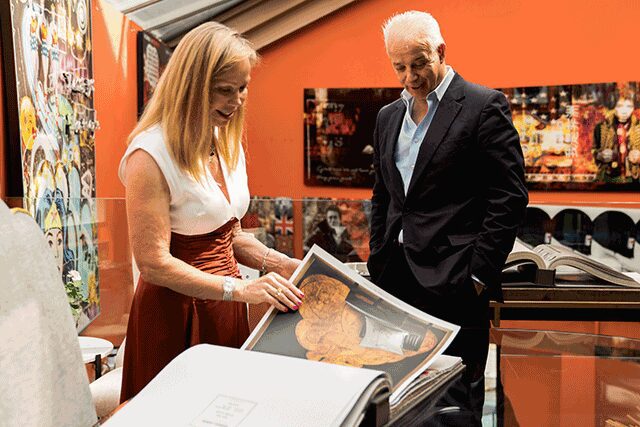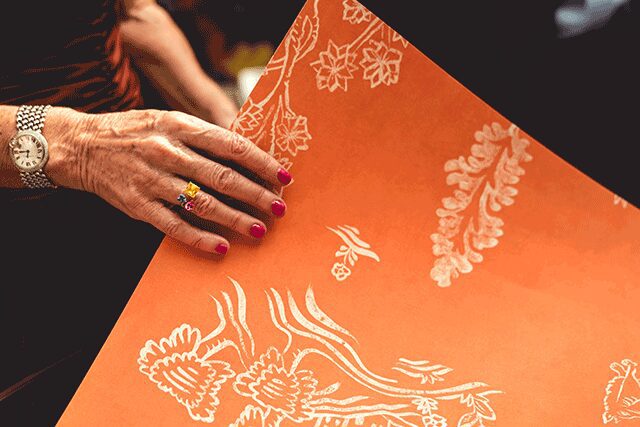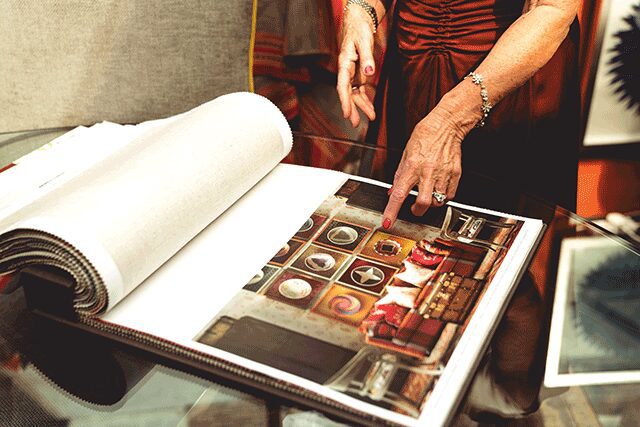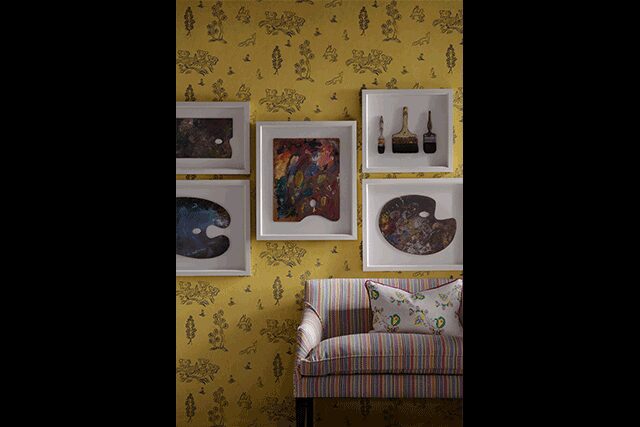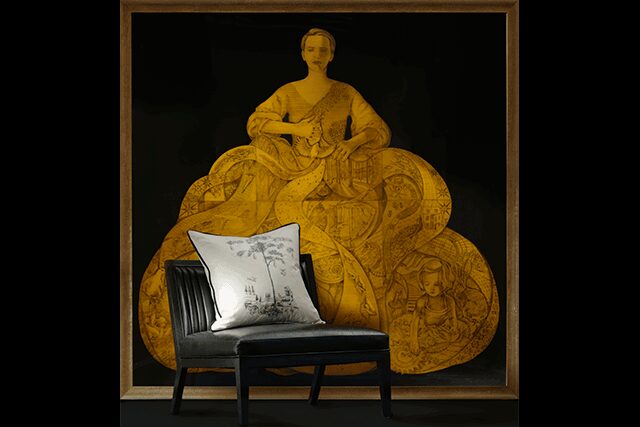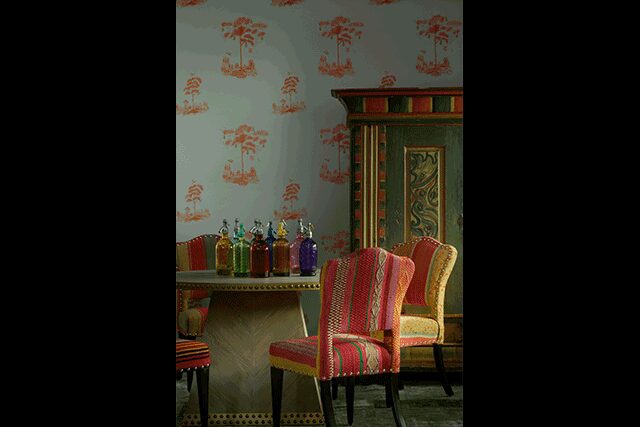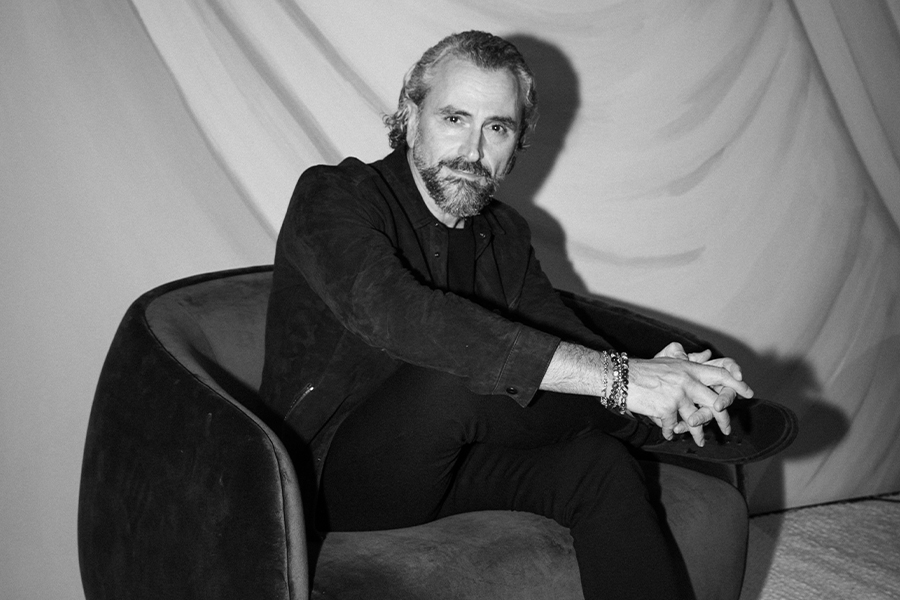Before Kit Kemp won the coveted Andrew Martin Interior Designer of the Year Award in 2008, she was an admirer of the eclectic and intrepid global design brand, established in London in 1978. Like her, the emporium’s founder, Martin Waller, is an original thinker. As friends and mutual supporters, they’ve waited for the right opportunity to work together, finally joining forces in 2018 on a range of fabrics and wallpapers for the Kit Kemp for Andrew Martin collection (available through Kravet in the U.S.). Reunited in the brand’s Walton Street showroom, the duo talked about design originality, celebrity, color, and collaboration.
On rethinking hotels
Martin Waller: When Kit won our award, she had just done Haymarket Hotel. There was a kind of template for hotel design, an accepted way of doing things, but the marvelous thing about Kit is she never got the memo.
Kit Kemp: I love that description.
MW: You reinvented the way hotels can look. Looking back at the post-war travel boom, there were some horrible hotels. The big chains came in and improved basic standards, but they were generic. And that’s what people wanted—the reassurance of a generic product. Things stayed that way until the ’80s when Kit became one of a handful of designers to change design attitudes.
KK: For me, it was all about the sense of arrival. When you’re traveling en masse by airplane, arriving at your hotel signals the start of an adventure. Today, when so many high streets have the same multiples and chains, we look to hotels to capture our imagination.
MW: That’s so true. Hotels provide individuality on identical high streets.
On the creative process
KK: I never knew there was a template, so it was easy to ignore. Having said that, I have had to design by stealth at times because there will always be people who say you can’t do something a certain way. If you talk about vivid turquoise and lacquer, people will say they don’t like them. But when you complete the look and have the Yves Klein-blue coffee table with liquorice allsort stools, they see how fabulous it is.
MW: I’m not so keen on discussing projects in advance. You tend to lose some of the excitement when it comes to the big reveal.
KK: The beginning of a project is always important to me for the flow. With event spaces, if you have seven gatherings happening at the same time, you don’t want to hear or see each other. So the very first and last parts are crucial. You shouldn’t be able to visualize the whole thing on the first day. There’s always a building process for us on projects, so ideas have to keep moving.
MW: You’re much braver than I am.
KK: Martin has always underplayed his role in design. To do what you’ve done in retail, all the rules you’ve broken by putting together different styles, fabrics, lighting, furniture, now that can only be done by a master. You became one of the first destinations for people looking for new ideas, and that remains true. I see a lot of interior designers whose work is faultless, but not necessarily creative. Ours sparks something in the imagination.
MW: My children tell me what I do is weird, but in the end, weird is good.
On the importance of storytelling
KK: It’s amazing when I think of the stories you’ve told since the ’70s. Through Martin’s eyes, you realize the world is a small place. It’s like anthropology. Everything merges and you see the links between different tribes and nations. The other thing we have in common is that we are great collectors. What you collect doesn’t have to be expensive, but when you place them together, they start talking to you.
MW: When I think back to the ’70s, I like to say it’s the decade that taste forgot.
KK: But it did all start there.
MW: Yes, it was an astonishingly creative decade. We did wear extremely embarrassing clothes, but fortunately, the internet didn’t exist. At the time, it was all about geometrical patterns, bold colors, and the space age. We all thought we’d be walking around in white vinyl jumpsuits, eating pills, and traveling around in jet packs by now.
KK: It was a bubbling hot pot.
MW: Astonishingly fertile. There was a certain confidence that allowed for wildness, but nowadays, most designers prefer to play it safe.
On design’s evolution
MW: Taste is not an absolute. Design is an evolution. The Andrew Martin style has changed considerably. In the ’80s, we were mad about Rajasthani artifacts, dhurrie rugs, and big doors. Then there was Scandinavian before a move to Chinese trunks and wedding cabinets. So many Buddhas in the ’90s, and then tribal came along.
KK: Now you see more of an element of celebrity.
MW: Yes, a little bit of the legacy of [Andy] Warhol—Pop Art and those screen prints of his.
KK: Social media has been good for design because you can enter into somebody else’s world and create a live scrapbook of what you love on Pinterest. People are much more sophisticated and knowledgeable because of it.
MW: Film and television used to be inspirational, but now you don’t even have to leave your bedroom.
KK: Hotels have become so much more, too. They’re not just somewhere you go and stay. We provide leisure activities such as art walks and literary talks because people want a living space in which they can get involved.
MW: Hotels are like musicals—they don’t work unless you have a great story, acting, dancing, and music. What you also tap into wonderfully is how people are able to recapture the experience. They get inspired and want to experiment with darker walls, patterns, and colors at home.
KK: I love strong color and bold interiors, but my spaces shouldn’t be too frantic or too timid. It’s the place in between.
MW: That’s the skill of your tightrope. Making something relaxing while showing such courage.

The Bloomsbury sofa with Friendly Folk cushions done in Melon Orange and Huntsman Red to match the Wychwood wallpaper
On collaborating
KK: When I’m expanding my own team, there’s no shortage of people who are strong on architecture or design, but that’s not so true when it comes to understanding color and fabric from a textural point of view. I look for someone who loves the loom. Part of it is instinct and innate skill, but the other part is the experience.
MW: That comes through with your collection. The idea of working with someone like Kit is that you get her point of view. It sounds obvious, but there are a lot of licenses that bear no reflection on the name on the cover.
KK: When Martin came along with his design director, David Harris, to view our ideas, it was nerve-racking. But the process was fun because we got to travel to factories in north England. Lancaster has so much historical knowledge when it comes to fabric and textile production. I hope that doesn’t miss the next generation.
MW: Makers are so important. The people mixing colors in sample tins have such a big role to play.
KK: You need a lot of texture within a background to give fabric its depth. They have the know-how to do this brilliantly. Before we began, I’d visited S Franses on Jermyn Street [in London] to see their historical tapestries and cartoons. I left fascinated by the large leaves and creatures. We’ve been inspired by a centuries-old tradition, but we’ve given it a new lease of life by making it look wholly contemporary. Our love of folk art comes through strongly.
MW: Yes, that aspect is deeply embedded in our DNA. We’ve seen folk and heraldic art our whole lives in churches, museums, and old buildings. We recognize it somewhere deep in our souls.
KK: When we visited the factories, we were able to draw on their deep knowledge of fabrics, using a linen mix for the Friendly Folk design and robust cotton twill for Hedgerow. There’s also a surprising chintz in a contemporary design we’ve named Pear Tree. It’s so out of fashion, but chintz has a lovely finish and it’s been fun to modernize it.
MW: The collection has been so well-received. People understand how to use it because of the way it’s presented, which is amazing when you think how complex your work is.
KK: I wanted a collection that would be usable, accessible, and not too expensive.
MW: The giant repeat called Mythical Land is one of our most popular products. People love it. The collection has done so well, we’d love to do another.
